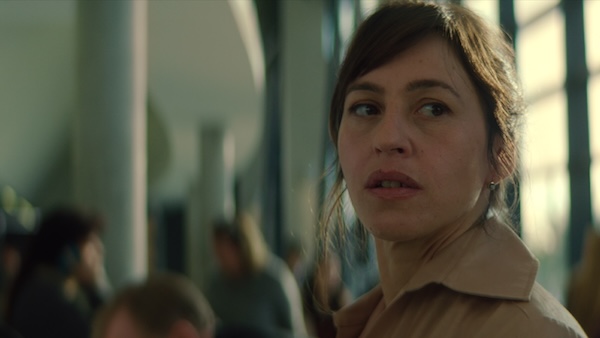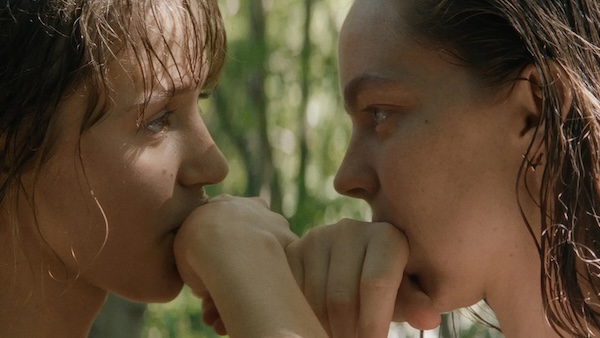Film Reviews: Tribeca Film Festival 2025 – A Few Discoveries
By David D’Arcy
As always, the festival supplied some revelations, plus films from countries now prominent in the news.

Tahereh in the Iranian documentary An Eye for an Eye. Photo: Unchained Productions
One bracing surprise this year was An Eye for an Eye, directed by Tanaz Eshaghian and Farzad Jafari. The Iranian documentary is built around a murder, the killing of a husband by his wife, who claims he was savagely violent. We enter the story after the wife, Tahereh, has completed a 14-year prison term. Now, according to Iranian law, the dead man’s family, her in-laws, can either choose to have her executed, or spare her life by opting to receive “blood money” compensation from her. The court decides on a fair price: argued down to around $19,000, and it’s up to the in-laws to decide.
The killing was a brutal end for a brutal man. “I killed him once, he killed us a thousand times. I don’t feel any regret at all,” says Tahereh, who stresses that she was denied a divorce. She and her three children, especially her young son Mohsen, plead for mercy.
The more we learn about the crime, the more the doc sounds like a horror film. (In fact, there is a horror feature of the same title opening soon.) The husband’s body was buried in secret; it was discovered only when flies swarmed around the grave. Yet, once the facts are established — and not all are — the drama focuses on the quest for mercy. That’s a challenge when the murder victim’s mother, the grandmother of Tahereh’s children, says “I hope she bleeds to death through her nose.… I want to see her suffer with my own eyes.”
We see many things in An Eye for an Eye — fear, hatred, greed, compassion, and more. The intimate but fevered negotiations over Tahereh’s future may not be a surprise for anyone familiar with Kim Longinotto and Ziba Mir-Hosseini’s revealing Divorce, Iranian Style (1998). Still, I don’t know any other documentary where viewers can watch negotiations among family members to determine whether someone can be legally executed or saved for a price. It’s hard to imagine a film about this legal practice, condoned by the Qur’an (which also calls for compassion), being distributed in the US, at least not during a war with Iran, even though the film is represented by the uber-powerful Creative Artists Agency (CAA). Look for this wrenching doc at festivals.

Sarah Adler in Dead Language. Photo: Tribeca
The setting couldn’t be more different in Dead Language, a study in deception and the earnest search for human connection. The drama, expanded from an Oscar-nominated short film by the Israeli directors Mihal Brezis & Oded Binnun, begins almost as a caper. Aya (Sarah Adler), waiting at the airport, is asked to hold a sign by a taxi driver who is desperate to visit the bathroom. She ends up greeting a consultant from Denmark and driving him in her car to Jerusalem. A connection is made, but not for long. Making excuses to her husband, Aya returns to the hotel, hoping that another experience with a traveler might occur. The lonely woman seeks human contact, yet she behaves like a mysterious nuisance. Things don’t end there.
The adventures of a bored but daring middle-aged wife (married to a specialist in dead languages) offer some odd encounters — set improbably in a security-conscious “Israeli” hotel and actually filmed in Prague — and Sarah Adler enlivens her character’s quest. The story travels in eccentric directions, each strand suggesting that every language is deficient in establishing connections between people. This may seem like a vague notion, until you see it dramatized, capped by a whimsical finale.
Dead Language is a Czech, Israeli, and Polish co-production, but it is the work of two Israeli directors. It is a rare Israeli film that is traveling internationally these days, unless you count Jewish film festivals, a parallel market. Audiences may view Aya’s disconnectedness — in her car, in hotel rooms, and in her own apartment — as a luxury compared to the devastation of wars that Israel now fights on two fronts and all over the media. That’s a proposition the film’s directors might enjoy debating — if Dead Language screens in the US beyond Tribeca.

A scene from Urška Djukić’s Little Trouble Girls. Photo: Tribeca
Another welcome discovery: Urška Djukić’s Little Trouble Girls, a film from Slovenia that Tribeca showed after its premiere in Berlin. This probing teenage drama is set in a Catholic girls’ school, where Lucija (Jara Sofija Ostan) has recently arrived. She has joined the choir, which is led by a young martinet of a choral director and is filled with catty girls who are eager to make trouble. It doesn’t help Lucija, the newcomer, that the choir performs a program that is harmonically challenging. The music, like this film’s eye for art and architecture, reveals an attention to detail and execution that makes for cinematic surprises throughout.
When the choir travels to Cividale del Friuli, over the border in Italy, things heat up. The Renaissance convent where they rehearse is under renovation. The workers damage a statue of the Virgin — a portent? — but the teenage girls are more concerned with looking at the buff sweaty guys. A few classmates sneak away to spy on the workmen swimming nude, and Lucija goes along. The girls, seeing that their sheltered classmate lacks experience with boys, bully her with tricks and teasing. In a radiant setting, things get ugly. But Lucija is given an active dream life by Djukić, who finds a visual language that takes off in myriad directions, drawing more from the treasures of the convent than from the men sweating in the courtyard.
Close-ups make up much of the film. Ostan in the lead has the face of an innocent who stumbles into a place where others seize on her inexperience. Her performance comes more through her facial expressions than from the sparse dialogue. The effect is a simple tale that (to generalize) has a European discretion that reveals itself with subtlety. Some who see Little Trouble Girls might feel shortchanged by Djukić’s uncertain ending. But maybe that’s the point. Often, youth is about finding yourself before finding your own way. We’ll see more from this actress and director.

Helen Mrugalski in Nayra Ilic Garcia’s Cuerpo Celeste. Photo: Tribeca
Cuerpo Celeste, from Chile, won a top prize at Tribeca. This drama, directed by Nayra Ilic Garcia, is built around Celeste, a restless teenage girl, played by Helen Mrugalski, and the story ends as an eclipse begins, hence the allusion to celestial bodies.
Part of the film is a coming-of-age story set in 1990. Celeste, with a broad, serene face that breaks into laughter or rage, is in the barren, desolate north of the country with her archaeologist father and his partner and a gaggle of young friends who gossip and act silly. The landscape of rock formations is staggering, on a scale far beyond human proportions, like a sculpture garden of gigantic works in stone, where people feel like tiny interlopers. Vehicles are outfitted with tent-like extensions to fend off the intense sun; the terrain is rugged, but fun. Things change after Celeste’s father collapses and dies on the beach. For the rest of the film, she is wary, belligerent, and hurt.
In 1990, history was made when the military strongman who led Chile’s 1973 US-backed coup, Augusto Pinochet, stepped down from office. Celeste and company are camping in the Atacama Desert, which holds evidence of his regime’s crimes. This is one of the driest places on earth: researchers like Celeste’s father and a growing number of souvenir seekers scrape the ground for fossils. In the same landscape, relatives of “disappeared” prisoners from the Pinochet era search for human remains where enemies of the military regime were dumped in the ground.
Cuerpo Celeste can feel like an odd mix of things. Impatient teenagers mingle in the vast sand and stone-scape as objects emerge from the ground. Everyone is hemmed in by an unchanging, monumental topography.
For those seeking context for Cuerpo Celeste, there is the understated but stunning 2010 documentary Nostalgia for the Light by Patricio Guzman (a post-1973 exile), which follows families searching for traces of loved ones sent to the desert by Pinochet. In that boundless landscape, they scratch the ground to connect memories to fragments, often not more than fingernails and bones.
David D’Arcy lives in New York. For years, he was a programmer for the Haifa International Film Festival in Israel. He writes about art for many publications, including the Art Newspaper. He produced and co-wrote the documentary Portrait of Wally (2012), about the fight over a Nazi-looted painting found at the Museum of Modern Art in Manhattan.
